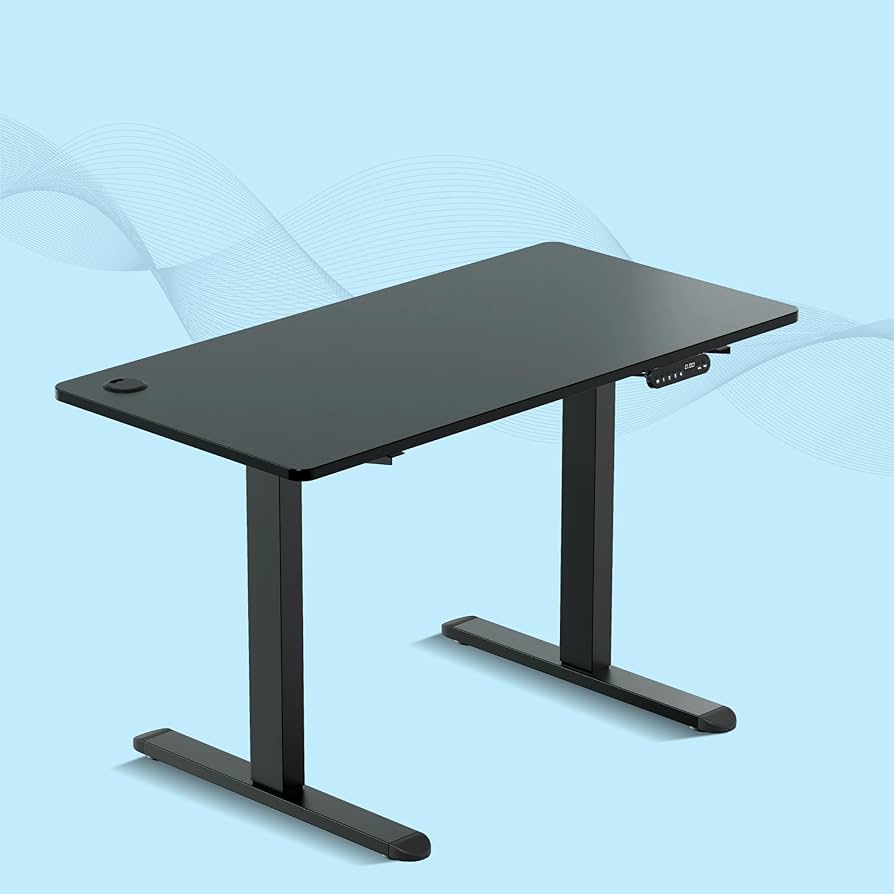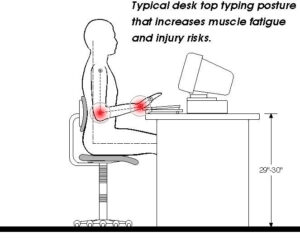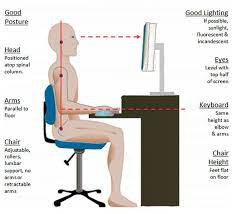

We have all been there — after a long day at work, your neck feels stiff, sore, and heavy.
That dull ache in your neck makes it hard to focus and enjoy the rest of your day.
The root of the problem?
Likely, your desk setup!
If your workstation is not set up properly, it can have long-term effects on your posture and lead to persistent neck pain.
But here is the good news: with a few adjustments to your ergonomic desk setup, you can fix your neck posture and say goodbye to those uncomfortable aches.
Let us dive in!
Article Index:
- Introduction: Why Desk Ergonomics Matter for Neck Posture
- The Role of an Ergonomic Desk in Neck Health
- Step-by-Step Guide to Setting Up an Ergonomic Desk for Better Neck Posture
- Monitor Placement
- Chair Height and Posture Support
- Keyboard and Mouse Placement
- Desk Surface and Layout
- Lighting Considerations
- Why Poor Desk Setup Leads to Bad Neck Posture
- Ergonomic Solutions for Common Neck Issues
- Daily Habits and Adjustments to Support Better Neck Health
- Conclusion: The Key to Fixing Your Neck Posture is Your Ergonomic Desk Setup
Why Desk Ergonomics Matter for Neck Posture?
I have had my fair share of neck pain due to poor workstation setup, and trust me, it is no walk in the park.
Like many of us, I spend hours at my desk every day, working on a computer.
But after months of ignoring my discomfort, I realized that my desk and how I used it were slowly wrecking my posture.
If you are reading this, chances are you’re experiencing something similar.
You might be surprised to learn that setting up an ergonomic desk set does not just make you more comfortable; it can also be one of the most effective ways to improve your neck posture.
This guide will walk you through all the necessary adjustments to fix your bad neck posture, step-by-step, and backed by science!
The Role of an Ergonomic Desk in Neck Health
Your neck is a delicate structure, supporting your head and acting as the main bridge between your brain and body.
Prolonged sitting at a desk that lacks ergonomic optimization can force your neck into awkward positions, leading to muscle strain over time.
Implementing an ergonomic desk setup is essential to prevent this strain and maintain neck health.
Key Considerations for an Ergonomic Workspace
Monitor Placement – Position your computer monitor at eye level and an arm’s length away to prevent unnecessary neck flexion or extension. According to the Mayo Clinic, ensuring proper monitor height and distance is crucial to avoiding neck and eye discomfort.
Chair Selection and Adjustment – Use a chair that supports the natural curve of your spine. Adjust the seat height so your feet rest flat on the floor, with knees at a 90-degree angle. Proper armrest positioning helps relax the shoulders and maintain spinal alignment, reducing neck muscle tension. The Mayo Clinic highlights that poor chair ergonomics contribute to chronic neck pain and posture issues.
Desk Height and Layout – Ensure your desk height allows for a neutral wrist position while typing, with forearms parallel to the floor. Keep frequently used items within easy reach to prevent unnecessary stretching, which can strain the neck and shoulders.
Keyboard and Mouse Positioning – Place the keyboard and mouse at the same level and close enough to prevent overreaching. Learning correct keyboard placement can fix text neck. Wrists should remain straight, and hands should be at or slightly below elbow level, reducing stress on the upper body.
Regular Movement and Breaks – Even with an optimal ergonomic setup, taking regular breaks is essential. Standing, stretching, and moving around every 30 minutes can help reduce muscle fatigue and improve circulation. According to Johns Hopkins Medicine, prolonged static postures contribute to neck and back pain, making movement a key factor in reducing discomfort.
Scientific studies reinforce the importance of ergonomic interventions.
A study published in the Journal of Physical Therapy Science found that ergonomic training combined with therapeutic exercises significantly reduces neck pain and improves posture among office workers.
In summary, an ergonomic desk setup is crucial for maintaining neck health and preventing discomfort.
By properly arranging your workspace and incorporating regular movement into your routine, you can reduce the risk of neck strain and improve overall well-being.
Step-by-Step Guide to Setting Up an Ergonomic Desk for Better Neck Posture
Let us break down the ergonomic changes you can make to ensure your neck stays in a neutral and healthy position while you work.
Monitor Placement
Your monitor’s position is critical in maintaining proper neck posture.
It should be directly in front of you, with the top of the screen at or just below eye level.
This prevents the need to look down or up, which can strain your neck.
- Tip: Your monitor should be about an arm’s length away. For dual monitors, ensure they are at equal distances to avoid turning your head repeatedly. I use a small ergonomic computer desk, which fits my setup perfectly without clutter.
Chair Height and Posture Support
An ergonomic office desk setup works best when paired with the right chair.
Your chair should allow your feet to rest flat on the floor, with your knees at a 90-degree angle.
- Tip: The back of your chair should support your lower back, promoting a neutral spine position. This support prevents you from slouching, which is a significant cause of neck pain.
Keyboard and Mouse Placement
Your keyboard and mouse should be positioned close to you, allowing your arms to bend at a 90-degree angle.
Your wrists should be straight while typing, avoiding awkward angles that put strain on your neck and shoulders.
- Tip: If you are using an ergo workstation, consider getting a keyboard tray to ensure your arms and wrists are well-positioned. I switched to a split keyboard for better neck alignment, and it made a huge difference.
Desk Surface and Layout
Your desk should provide enough space to allow for a comfortable setup.
Keep frequently used items (like your phone or notepad) within easy reach to prevent overreaching, which can cause shoulder and neck strain.
- Tip: I upgraded to a small ergonomic desk, which helped minimize clutter while offering just enough space for my essentials.
Lighting Considerations
Good lighting is often overlooked but is essential for maintaining proper neck posture.
Straining to see a poorly lit screen can cause you to lean forward, increasing the load on your neck.
- Tip: Ensure that your workspace has sufficient lighting to reduce eye strain. A desk lamp or adjustable task lighting can make a world of difference in ensuring proper neck posture.
Why Poor Desk Setup Leads to Bad Neck Posture?
So why does bad posture happen at our desks?
Imagine slouching forward or craning your neck down for hours at a time.
This unnatural position places immense pressure on your cervical spine (the part of your spine in your neck), leading to strain and discomfort.
A study in Occupational Medicine showed that poor workplace desk ergonomics is a major factor in neck strain.
When your desk and chair aren’t correctly aligned, your body compensates by adopting unhealthy positions, which, over time, become your default posture.
This is exactly what happened to me before I learned about proper ergonomic desk set up.
Ergonomic Solutions for Common Neck Issues
One of the most common causes of neck pain is the “forward head posture” — where your head is pushed forward in front of your shoulders.
This can add up to 10 extra pounds of pressure on your neck for every inch your head is forward!
To fix this, adjust your monitor and chair as described above.
The use of an ergonomic office desk can make a significant difference in maintaining correct posture throughout the day.
Some additional solutions include:
- Ergonomic desk chairs with adjustable lumbar support.
- Using a laptop stand with an external keyboard and mouse for better alignment.
- Regular stretching and posture-correcting exercises.
Daily Habits and Adjustments to Support Better Neck Health
Even with the perfect correct ergonomics for desk, habits play a big role in your posture.
Here are a few things I personally found useful:
- Frequent Breaks: Stand up, stretch, and walk around every 30 minutes to avoid stiffness.
- Mind Your Posture: Be aware of how you sit. If you catch yourself slouching, readjust to maintain the proper spinal alignment.
- Stretching: Incorporate neck and shoulder stretches into your day. Simple exercises like neck rolls and shoulder shrugs can relieve tension.
- Use of Phone or Tablet: When using devices, avoid looking down for extended periods. Hold phone screen at eye level to keep your neck in a neutral position.
The Key to Fixing Your Neck Posture is Your Ergonomic Desk Setup
To answer the question posed by this article: Yes, setting up an ergonomic desk is absolutely key to achieve the best forward head posture fix!
By ensuring your monitor, chair, and keyboard are all in alignment with proper desk ergonomics, you significantly reduce the strain on your neck and shoulders.
Remember, your ergonomic desk setup is an investment in your long-term health.
Make those small adjustments today, and your neck will thank you tomorrow!
Just like I did, you will notice a dramatic improvement in how you feel at the end of each workday.
Take care of your neck — it is the foundation of your posture, and it all starts with a well-set-up ergo workstation.
References:


